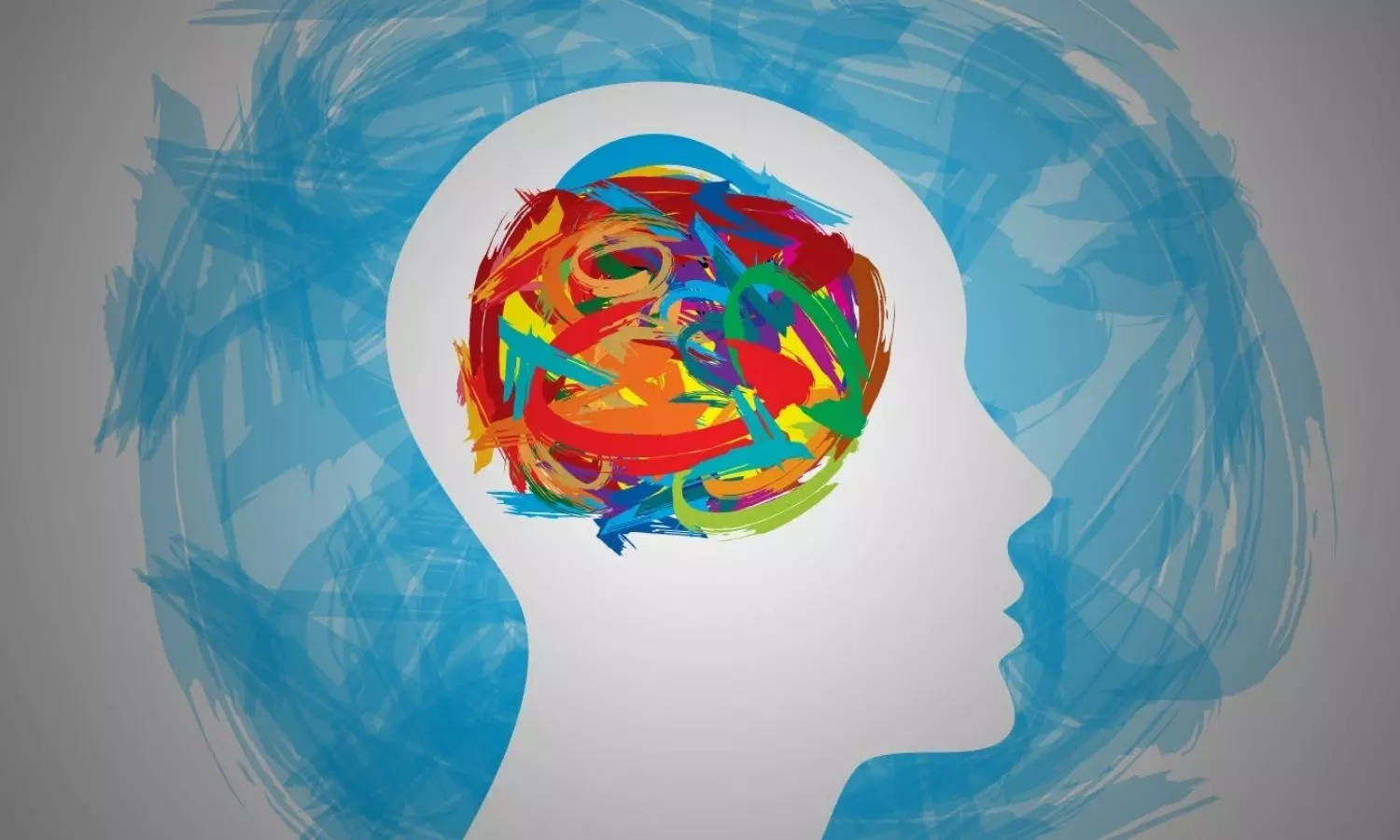Schizophrenia is characterized by psychosis (loss of contact with reality), hallucinations (false perceptions), delusions (false beliefs), disorganized speech and behavior, flattened affect (restricted range of emotions), cognitive deficits (impaired reasoning and problem solving), and occupational and social dysfunction. The cause is unknown, but evidence for genetic and environmental components is strong. Symptoms usually begin in adolescence or early adulthood. One or more episodes of symptoms must last ≥ 6 months before the diagnosis is made. Treatment consists of drug therapy, cognitive therapy, and psychosocial rehabilitation. Early detection and early treatment improve long-term functioning.

Psychosis refers to symptoms such as delusions, hallucinations, disorganized thinking and speech, and bizarre and inappropriate motor behavior (including catatonia) that indicate loss of contact with reality.
Worldwide, the prevalence of schizophrenia is about 1%. The rate is comparable among men and women and relatively constant cross-culturally. Urban living, poverty, childhood trauma, neglect, and prenatal infections are risk factors, and there is a genetic predisposition. The condition starts in late adolescence and lasts a lifetime, typically with poor psychosocial function throughout.
The average age at onset is early to mid 20s in women and somewhat earlier in men; about 40% of males have their first episode before age 20. Onset is rare in childhood; early-adolescent onset or late-life onset (when it is sometimes called paraphrenia) may occur.
Etiology of Schizophrenia
Although its specific causes and mechanisms are unknown, schizophrenia has a biologic basis, as evidenced by
Alterations in brain structure (eg, enlarged cerebral ventricles, thinning of the cortex, decreased size of the anterior hippocampus and other brain regions)
Changes in neurochemistry, especially altered activity in markers of dopamine and glutamate transmission
Recently demonstrated genetic risk factors (1)
Some experts suggest that schizophrenia occurs more frequently in people with neurodevelopmental vulnerabilities and that the onset, remission, and recurrence of symptoms are the result of interactions between these enduring vulnerabilities and environmental stressors.
Neurodevelopmental vulnerability
Although schizophrenia rarely manifests in early childhood, childhood factors influence disease onset in adulthood. These factors include
- Genetic predisposition
- Intrauterine, birth, or postnatal complications
- Viral central nervous system infections
- Childhood trauma and neglect
Although many people with schizophrenia do not have a family history, genetic factors are strongly implicated. People who have a 1st-degree relative with schizophrenia have about a 10 to 12% risk of developing the disorder, compared with a 1% risk among the general population. Monozygotic twins have a concordance of about 45%.
Maternal exposure to famine and influenza during the 2nd trimester of pregnancy, birth weight < 2500 g, Rh incompatibility during a 2nd pregnancy, and hypoxia increase risk.
Neurobiologic and neuropsychiatric tests suggest that aberrant smooth-pursuit eye tracking, impaired cognition and attention, and deficient sensory gating occur more commonly among patients with schizophrenia than among the general population. These findings also can occur among 1st-degree relatives of people with schizophrenia, and indeed in patients with many other psychotic disorders, and may represent an inherited component of vulnerability. The commonality of these findings across psychotic disorders suggests that our conventional diagnostic categories do not reflect underlying biologic distinctions among psychoses (1).
Environmental stressors
Environmental stressors can trigger the emergence or recurrence of psychotic symptoms in vulnerable people. Stressors may be primarily pharmacologic (eg, substance use, especially marijuana) or social (eg, becoming unemployed or impoverished, leaving home for college, breaking off a romantic relationship, joining the Armed Forces). There is emerging evidence that environmental events can initiate epigenetic changes that could influence gene transcription and disease onset.
Protective factors that may mitigate the effect of stress on symptom formation or exacerbation include strong psychosocial support, well-developed coping skills, and antipsychotic drugs.

Symptoms and Signs of Schizophrenia
Schizophrenia is a chronic illness that may progress through several phases, although duration and patterns of phases can vary. Patients with schizophrenia tend to have had psychotic symptoms an average of 8 to 15 months before presenting for medical care, but the disorder is now often recognized earlier in its course.
Symptoms of schizophrenia typically impair the ability to perform complex and difficult cognitive and motor functions; thus, symptoms often markedly interfere with work, social relationships, and self-care. Unemployment, isolation, deteriorated relationships, and diminished quality of life are common outcomes.
Phases of schizophrenia
In the prodromal phase, individuals may show no symptoms or may have impaired social competence, mild cognitive disorganization or perceptual distortion, a diminished capacity to experience pleasure (anhedonia), and other general coping deficiencies. Such traits may be mild and recognized only in retrospect or may be more noticeable, with impairment of social, academic, and vocational functioning.
In the advanced prodromal phase, subclinical symptoms may emerge; they include withdrawal or isolation, irritability, suspiciousness, unusual thoughts, perceptual distortions, and disorganization (1). Onset of overt schizophrenia (delusions and hallucinations) may be sudden (over days or weeks) or slow and insidious (over years). But, even in an advanced prodromal phase, only a fraction (< 40%) tend to convert to full schizophrenia.
In the early psychosis phase, symptoms are active and often at their worst.
In the middle phase, symptomatic periods may be episodic (with identifiable exacerbations and remissions) or continuous; functional deficits tend to worsen.
In the late illness phase, the illness pattern may become established but there is considerable variability; disability may stabilize, worsen, or even diminish.
Symptom categories in schizophrenia
Generally, symptoms are categorized as
- Positive: Hallucinations and delusions
- Negative: Diminution or loss of normal functions and affect
- Disorganized: Thought disorder and bizarre behavior
- Cognitive: Deficits in memory, information processing and problem solving
Patients may have symptoms from one or all categories.
Positive symptoms can be further categorized as
Delusions are erroneous beliefs that are maintained despite clear contradictory evidence. There are several types of delusions:
- Persecutory delusions: Patients believe they are being tormented, followed, tricked, or spied on.
- Delusions of reference: Patients believe that passages from books, newspapers, song lyrics, or other environmental cues are directed at them.
- Delusions of thought withdrawal or thought insertion: Patients believe that others can read their mind, that their thoughts are being transmitted to others, or that thoughts and impulses are being imposed on them by outside forces
Delusions in schizophrenia tend to be bizarre—ie, clearly implausible and not derived from ordinary life experiences (eg, believing that someone removed their internal organs without leaving a scar).
Hallucinations are sensory perceptions that are not perceived by anyone else. They may be auditory, visual, olfactory, gustatory, or tactile, but auditory hallucinations are the most common. Patients may hear voices commenting on their behavior, conversing with one another, or making critical and abusive comments. Delusions and hallucinations may be extremely vexing to patients.
Negative (deficit) symptoms include
- Blunted affect: The patient’s face appears immobile, with poor eye contact and lack of expressiveness.
- Poverty of speech: The patient speaks little and gives terse replies to questions, creating the impression of inner emptiness
- Anhedonia: There is a lack of interest in activities and increased purposeless activity.
Asociality: There is a lack of interest in relationships.
Negative symptoms often lead to poor motivation and a diminished sense of purpose and goals.
Disorganized symptoms, which can be considered a type of positive symptom, involve
- Thought disorders
- Bizarre behaviors
Thinking is disorganized, with rambling, non–goal-directed speech that shifts from one topic to another. Speech can range from mildly disorganized to incoherent and incomprehensible. Bizarre behavior may include childlike silliness, agitation, and inappropriate appearance, hygiene, or conduct. Catatonia is an extreme example of bizarre behavior, which can include maintaining a rigid posture and resisting efforts to be moved or engaging in purposeless and unstimulated motor activity.
Cognitive deficits include impairment in the following:
- Attention
- Processing speed
- Working and declarative memory
- Abstract thinking
- Problem solving
Understanding of social interactions
The patient’s thinking may be inflexible, and the ability to problem solve, understand the viewpoints of other people, and learn from experience may be diminished. Severity of cognitive impairment is a major determinant of overall disability.
Subtypes of schizophrenia
Some experts classify schizophrenia into deficit and nondeficit subtypes based on the presence and severity of negative symptoms, such as blunted affect, lack of motivation, and diminished sense of purpose.
Patients with the deficit subtype have prominent negative symptoms unaccounted for by other factors (eg, depression, anxiety, an understimulating environment, drug adverse effects).
Those with the nondeficit subtype may have delusions, hallucinations, and thought disorders but are relatively free of negative symptoms.
The previously recognized subtypes of schizophrenia (paranoid, disorganized, catatonic, residual, undifferentiated) have not proved valid or reliable and are no longer used.
Suicide
About 5 to 6% of patients with schizophrenia commit suicide, and about 20% attempt it; many more have significant suicidal ideation. Suicide is the major cause of premature death among people with schizophrenia and explains, in part, why on average the disorder reduces life span by 10 years.
Risk may be especially high for young men with schizophrenia and a substance use disorder. Risk is also increased in patients who have depressive symptoms or feelings of hopelessness, who are unemployed, or who have just had a psychotic episode or been discharged from the hospital.
Patients who have late onset and good premorbid functioning—the very patients with the best prognosis for recovery—are also at the greatest risk of suicide. Because these patients retain the capacity for grief and anguish, they may be more prone to act in despair based on a realistic recognition of the effect of their disorder.
Violence
Schizophrenia is a surprisingly modest risk factor for violent behavior. Threats of violence and aggressive outbursts are more common than seriously dangerous behavior. Indeed, people with schizophrenia are overall less violent than people without schizophrenia.
Patients more likely to engage in significant violence include those with substance use disorders, persecutory delusions, or command hallucinations and those who do not take their prescribed drugs. A very few severely depressed, isolated, paranoid patients attack or murder someone whom they perceive as the single source of their difficulties (eg, an authority, a celebrity, their spouse).

Treatment of Schizophrenia
- Antipsychotic drugs
- Rehabilitation, including cognitive remediation, community-based training, and support services
- Psychotherapy, oriented toward resilience training
The time between onset of psychotic symptoms and first treatment correlates with the rapidity of initial treatment response and quality of treatment response. When treated early, patients respond more quickly and fully. Without ongoing use of antipsychotics after an initial episode, 70 to 80% of patients have a subsequent episode within 12 months. Continuous use of antipsychotics can reduce the 1-year relapse rate to about 30% or lower with long-acting drugs. Drug treatment is continued for at least 1 to 2 years after a first episode. If patients have been ill longer, it is given for many years.
Early detection and multifaceted treatment has transformed care of patients with psychotic disorders like schizophrenia. Coordinated specialty care, which includes resilience training, personal and family therapy, addressing cognitive dysfunction, and supported employment, is an important contribution to psychosocial recovery.
General goals for schizophrenia treatment are to
- Reduce the severity of psychotic symptoms
- Preserve psychosocial function
- Prevent recurrences of symptomatic episodes and associated deterioration of functioning
- Reduce use of recreational drugs
Antipsychotics, rehabilitation with community support services, and psychotherapy are the major components of treatment. Because schizophrenia is a long-term and recurrent illness, teaching patients illness self-management skills is a significant overall goal.
- Source: https://www.msdmanuals.com -
Etiology reference
1. Schizophrenia Working Group of the Psychiatric Genomics Consortium: Biological insights from 108 schizophrenia-associated genetic loci. Nature 511(7510):421-427, 2014. doi: 10.1038/nature13595
Symptoms reference
1. Tsuang MT, Van Os J, Tandon R, et al: Attenuated psychosis syndrome in DSM-5. Schizophr Res 150(1):31–35, 2013. doi: 10.1016/j.schres.2013.05.004
General treatment references
1. Correll CU, Rubio JM, Inczedy-Farkas G, et al: Efficacy of 42 pharmacologic cotreatment strategies added to antipsychotic monotherapy in schizophrenia: Systematic overview and quality appraisal of the meta-analytic evidence. JAMA Psychiatry 74(7):675-684, 2017. doi: 10.1001/jamapsychiatry.2017.0624
2. Wang SM, Han C, Lee SJ: Investigational dopamine antagonists for the treatment of schizophrenia. Expert Opin Investig Drugs 26(6):687-698, 2017. doi: 10.1080/13543784.2017.1323870
American Psychiatric Association (APA), Clinical Practice Guidelines for Schizophrenia, 3rd Edition: Practice guidelines include information on the social determinants of mental health and on effectively using technology (including social media, telepsychiatry, and mental health apps) to provide optimal patient care.
National Alliance on Mental Illness (NAMI), Schizophrenia: NAMI promotes ongoing awareness of schizophrenia, as well as educational and advocacy initiatives to support those who have it, and crisis-response services (including a HelpLine) to assist those in need.